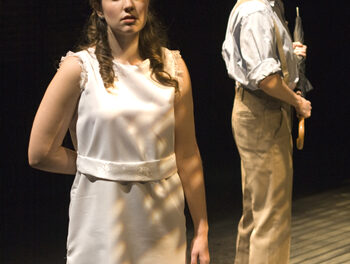This concert showed that even the generally older, staid and sober crowds that tend to show up at chamber music concerts can be smitten with youth and celebrity. As I arrived at Duke University’s Reynolds Auditorium, there was already a long line at the ticket window wanting to get on the waiting list to see pianist Simone Dinnerstein and cellist Zuill Bailey. Duke Performances scored quite a coup in landing what is currently the hottest — in both talent and looks — classical duo.
Dinnerstein was playing her final concert of a three day residency at Duke including a solo recital the night before. She is an “overnight sensation” story. A relatively unknown piano teacher in Brooklyn, she had the audacity to record Bach’s towering “Goldberg Variations” and hit critical and popular gold. Zuill Bailey has visited this area before both as a guest soloist with the North Carolina Symphony and as a member of the Perlman/Bailey/Schmidt piano trio. These artists got together to record the first volume of the complete works for piano and cello by Beethoven, and this concert was Ludwig all the way. An attractive brass floor lamp on the low end of the piano added a somewhat homey feel to the stage.
The early/young Beethoven was fairly conventional in that he liked to compose variations on many of the well-known operas of the day. His early forays into the cello/piano marriage had several of these variations and the program started with one based on a theme from Mozart’s The Magic Flute. This was a good starter to warm up and get some of the nerves and kinks out. The duo seemed tentative at first with some piano clunkers, rhythmic disarray and Bailey quickly correcting some faulty intonation. But by the end of this fairly typical classical work they were relaxed and cooking nicely together.
Bailey prefaced the first sonata of the evening, and the only words from the stage for the concert, by explaining the significance of Beethoven’s Cello Sonata No. 3. Beethoven was working with little precedent. Mozart and Haydn, nor any composer of merit since the Baroque period, had written works for cello and keyboard and those that existed (including the first two that Beethoven wrote) were quite piano-centric. Everything changed with his third sonata as the solo cello introduced the lovely first theme and continued on as an equal to its powerful 88-keyed partner. Bailey was always able to be heard, in no small part due to the sensitive playing of Dinnerstein. They were especially captivating in the deceptively difficult scherzo which appears on paper as simple but is rife with misplaced accents and phrasing that is characteristic of many of Beethoven’s scherzos.
The five cello sonatas are a body of work which closely parallel and exhibit the early/middle/late delineation of Beethoven’s style. The final two of Opus 102 morphed into compositions that are similar stylistically and emotionally to the late string quartets.
Although both of these flowed from the composer in a relatively brief time, these are both works which require a level of musical maturity and commitment that are a world away from the third sonata. The artists, individually and collectively, exhibited a mastery of dynamic range from nearly inaudible pianissimos to stage-shaking quadruple ffff’s.
They achieved something that every performing artist strives for: a total audience involvement where you can actually feel the collective emotional drawing in of the listener to every note and phrase. This, and the extremely rare occurrence of an audience with little or no coughing, interminable candy unwrapping or talking, made for a superb evening out.











